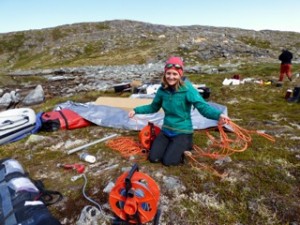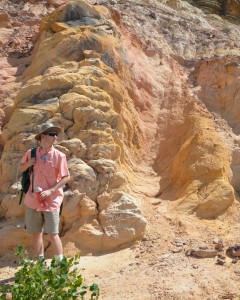Interglacial climate in northwest Greenland inferred using insect remains, leaf wax dD and chitin dO preserved in lake sediments
McFarlin, J., Axford, Y., Osburn, M., Kelly, M., Osterberg, E., Francis, D., Lasher, G., Farnsworth, L.
Monday, December 12 8-12:20pm in Moscone South
Abstract: Here we present a sub-millennial record of Holocene and Last Interglacial Period (130 ka BP) warming from northwest Greenland using chironomid-inferred temperature (CIT) and stable isotopes of precipitation (SIPs). This archive is the second record from all of Greenland following the NEEM ice core that captures continuous continental paleoclimate conditions of the Last Interglacial Period (Dahl-Jensen et al., 2013). Our record shows strong agreement with the upper estimates from NEEM (8±4°C) during peak LIG warming, with peak temperatures in the LIG exceeding those of the Holocene. These estimates are reflected in multiple independent proxies within the core, including SIPs, and further supported by the presence of subfossil Chaoboridae exuviae during peak LIG warmth.
The pairing of CIT and SIPs on this record provides valuable insight on how hydroclimate changed over Arctic Greenland during two different warm periods. This record directly compares the LIG with the Holocene and we find that SIPs from aquatic biomarkers behave differently than SIPs from terrestrial biomarkers, reflecting changes in not only temperature but also precipitation and effective moisture in the region in response to warming.
Frequency-size distributions of Wadati-Benioff zone and near-boundary, intraplate earthquakes
Jordan P. Todes, Emile A. Okal, Stephen H. Kirby
Thursday, December 15 8-12:20pm in Moscone South
Abstract: We conduct a systematic analysis of the frequency-moment distribution for a number of earthquake populations, motivated by the more than three-fold increase in the available CMT database since our previous study (Okal and Kirby, 1995; hereafter OK95), where some datasets may have been undersampled. We characterize our results in terms of variations in the parameter β, the absolute value of the slope of the logarithmic regression of population vs. seismic moment. We first examine global datasets boxed into 100-km depth slices. For most, we uphold the results of OK95: namely, β-values (before saturation) close to the theoretical 2/3 predicted under seismic similitude with a fractal dimension of 2 for the seismogenic zone. In the 500 to 600 km depth range, we obtain slightly lower β-values (0.57 vs. 0.66), and confirm a distinct behavior between the Tonga subduction zone, where β-values decrease (from 0.80 to 0.47) beyond the saturation elbow, and other provinces of deep seismicity, where they show an increase (from 0.38 to 0.82).
In addition, we report on a dataset of more than 600 normal faulting events in the outer rise region of subduction trenches. This population features a β-value close to 2/3; the similarity of β between intermediate- depth slab earthquakes (in the 100-200 km range) and this class of events would suggest that the former occur on reactivated faults already present in the lithosphere subducting at the trench. However, characteristics of the saturation elbow and post-saturation behavior are found to differ in the two populations. A smaller dataset of outer rise thrust earthquakes, expected to occur at greater depths in the subducting plate, also feature a typical β (0.59), with a steeper slope beyond saturation. By contrast, intraplate normal faulting events occurring in the vicinity of mid-ocean ridges are typified by a higher β-value (0.99), with a significant, inverse dependence on spreading rate.




